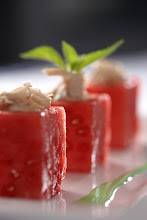The ozone thins. Natural resources wane. Wall Street seizes. In order to consciously combat depleting reserves and a topsy-turvy economy Creative Director Steve Welsh and Floral Designer Kim Vasil created a “sustainable table” for a recent annual fund-raising event. “Struggling with the aftermath of a recent drought, we wanted to send a strong message of conservation and sustainability by using plants that live off the moisture of their own leaf systems,” Welsh remarked.
Welsh, Vasil, and the design team pavéd the entire table surface with wheat grass, then added a series of vignettes using hearty succulents, cacti, and unique ground cover such as hens and chicks, flapjack succulents, and creeping sedum. One of the vignettes, for example, was a low row of sequential pencil cacti nestled in white landscaping rock—another was constructed with ground cover, jade, kale, and decorative moss balls. A quirky combination of kosher rock salt, split peas, and personalized name placards were visible through each hand-cut recycled glass section that topped each of the fourteen organic place settings. Many of the plants utilized in this design were so hearty that they also served as a perfect place to set butter dishes and votive candles. Another level of recycling consciousness came from our ability to present our guests with the actual potted plants from the tablescape as take-home gifts. Presenting our guests with some of the plants they’d been admiring all evening sent a resonating message of the gift of nature.
Since most of you don’t have an entire design team at your disposal, in regards to sustainable entertaining Floral Designer Kim Vasil says, “The most important thing to remember is to use what you already have—dig up something from your garden to use as a centerpiece, use antiques chockfull of personality. I have incorporated my collection of antique globes into my table designs on numerous occasions. Use anything that you can get your hands on to make your table more unique and festive—the more personal the better. Personality, in my opinion, always creates a lasting impression.”
Instead of spending money on party items that will likely be discarded later, access the rich vault of your personal possessions. Root around your garage. Bring a piece of forgotten furniture back to life with a fresh coat of bold paint. Surround your table with assorted hand-painted chairs for an eclectic feel. Incorporate a family heirloom from your what-not-shelf into your unique table décor. Use beakers from an old chemistry set for sugar and cream, a rack of test tubes as individual bud vases. Stand napkins vertically by using artful bookends. Open your refrigerator. Create a colorful centerpiece using bright orange tangerines and yellow lemons along with some garden fresh white daisies or roses. A variety of home grown flowers will work beautifully with a citrus centerpiece.
There are plenty of items in your home just waiting to be featured the next time you entertain. Whether you use an armful of flowers from your back yard or a handful of lemons from your refrigerator—sustainable entertaining is a win-win situation for everyone. The environment wins, your pocketbook wins, and you’ll win smiles from your guests for creating a memorable occasion with an earth-friendly spirit.
Also, it’s best to keep the environment in mind when sending out invitations. If you don’t use e-invitations, at least use soy ink on recycled paper. Promote sustainability as well when you’re planning your menu. Most people aren’t aware that the start-to-finish process of raising and distributing red meat causes more greenhouse gas emissions than any other food group. Choosing chicken or fish as your entrée is far less destructive to the environment. When selecting seafood, however, it’s best to select seafood that is responsibly harvested. Many fisheries continue unsustainable fishing practices and habitat destruction. For example—Atlantic cod, Chilean sea bass, and Yellowtail flounder are among the least environmentally-friendly and should be avoided at all costs. Pacific halibut, wild Alaskan salmon, and bay-farmed scallops are just a few examples of seafood that is responsibly farmed. To learn more about environmentally sustainable living and for a more extensive list of sustainable seafood choices go to
http://www.eartheasy.com/.
 Whether it’s with chocolate ganache cake, hazelnut cream truffles, praline filled bonbons or chocolate ice box pie—there are countless ways to feature chocolate in your entertaining. Chocolate is our Executive Pastry Chef Michael Martins' primary muse. His specialty cakes, petit fours, and truffles are truly remarkable—always velvety and delicious. A past life spent as a cocoa bean hanging off a cocoa branch in the Andes foothills is my only logical explanation for his innate chocolate abilities. That and, of course, over twenty years of pastry experience. One of my favorite chocolate desserts is his twist on the traditional Mississippi Mud Pie called “Oreo Mudslide Pie." This version is relatively simple to prepare and perfect for any special occasion. The recipe can be found in the February '09 issue of Affluent Magazine.
Whether it’s with chocolate ganache cake, hazelnut cream truffles, praline filled bonbons or chocolate ice box pie—there are countless ways to feature chocolate in your entertaining. Chocolate is our Executive Pastry Chef Michael Martins' primary muse. His specialty cakes, petit fours, and truffles are truly remarkable—always velvety and delicious. A past life spent as a cocoa bean hanging off a cocoa branch in the Andes foothills is my only logical explanation for his innate chocolate abilities. That and, of course, over twenty years of pastry experience. One of my favorite chocolate desserts is his twist on the traditional Mississippi Mud Pie called “Oreo Mudslide Pie." This version is relatively simple to prepare and perfect for any special occasion. The recipe can be found in the February '09 issue of Affluent Magazine.



